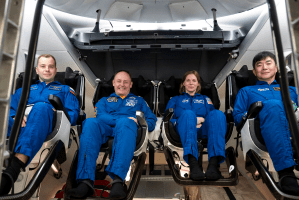NASA’s Human Research Program will fund 10 proposals to help answer questions about astronaut health and performance during future long-duration missions beyond low-Earth orbit. The selected proposals will investigate the effect the space environment has on various aspects of astronaut health, including the issues of space radiation and sensorimotor alterations. All of the selected projects will contribute to NASA’s long-term plans, which include crewed missions to the Moon and Mars.
The Human Research Program works to address the practical problems of spaceflight that impact astronaut health, and its research may provide knowledge and technologies that could improve human health and performance during space exploration and aid the development of potential countermeasures for problems experienced during space travel. The organization’s goals are to help astronauts complete their challenging missions successfully and to preserve their long-term health.
These investigations will take place in research laboratories and in ground-based analogs, which mimic various aspects of the spaceflight environment. Among the studies, Andrew Wyrobek, senior staff scientist at Lawrence Berkeley National Laboratory, will examine central nervous system pathways associated with radiation-damage response and neuropathology. Lonnie Petersen, postdoctoral fellow at the University of California-San Diego, will study how a lower body negative pressure suit can help prevent changes in vision some astronauts experience while in space. Steven Yule, assistant professor of Surgery at Harvard Medical School, will investigate how crew members perform together in a spaceflight analog setting to resolve simulated medical emergencies.
The selected proposals are from nine institutions in seven states and will receive a total of approximately $1.2 million during a one- to two-year period. The 10 projects were selected from 62 proposals received in response to the 2017 Human Exploration Research Opportunities Appendices A and B. Science and technology experts from academia, government, and industry reviewed the proposals.
As mentioned above, the Human Research Program quantifies crew health and performance risks during spaceflight and develops strategies that mission planners and system developers can use to monitor and mitigate these risks. These studies often lead to advancements in understanding and treating illnesses in patients on Earth.
The complete list of the selected proposals, principal investigators and organizations is:
· Michael Dorneich, Iowa State University in Ames, Iowa: “Adaptive stress training for hazardous conditions countermeasure”
· Peter Grabham, Columbia University in New York: “A determination of bioactive proteins secreted by the human vasculature in response to low dose space radiation”
· Naduparambil Jacob, Ohio State University in Columbus: “Predictive biomarkers for space radiation induced cancer and cardiovascular injury risk assessment”
· Satish Mehta, NASA’s Johnson Space Center in Houston: “Varicella zoster virus shedding after antiviral drug (Valacyclovir) treatment in Antarctic expeditioners”
· Lonnie Petersen, University of California, San Diego: “Mobile gravity suit (an integrative countermeasure device)”
· Millard Reschke, NASA’s Johnson Space Center: “Orion crew performance and safety immediately following post-flight water landings: emergency egress”
· William Toscano, NASA’s Ames Research Center in Silicon Valley, California: “Evaluation of an on-astronaut wireless sensor system (OAWSS) to support crew health monitoring for exploration class missions”
· Andrew Wyrobek, Lawrence Berkeley National Laboratory in Berkeley, California: “Variation in CNS damage signaling and blood sentinels of neuropathology after exposure to space radiation”
· Steven Yule, Brigham and Women’s Hospital/Harvard Medical School in Boston: “Simulation-based countermeasure development to mitigate team and system vulnerabilities during medical event management on long duration space missions”
· Ye Zhang, NASA’s Kennedy Space Center in Florida: “Effect of simulated solar particle events and galactic cosmic rays on crop growth and development”
_____
NASA’s Human Research Program, or HRP, pursues the best methods and technologies to support safe, productive human space travel. Through science conducted in laboratories, ground-based analogs, and the International Space Station, HRP scrutinizes how spaceflight affects human bodies and behaviors. Such research drives HRP’s quest to innovate ways that keep astronauts healthy and mission-ready as space travel expands to the Moon, Mars, and beyond.
































